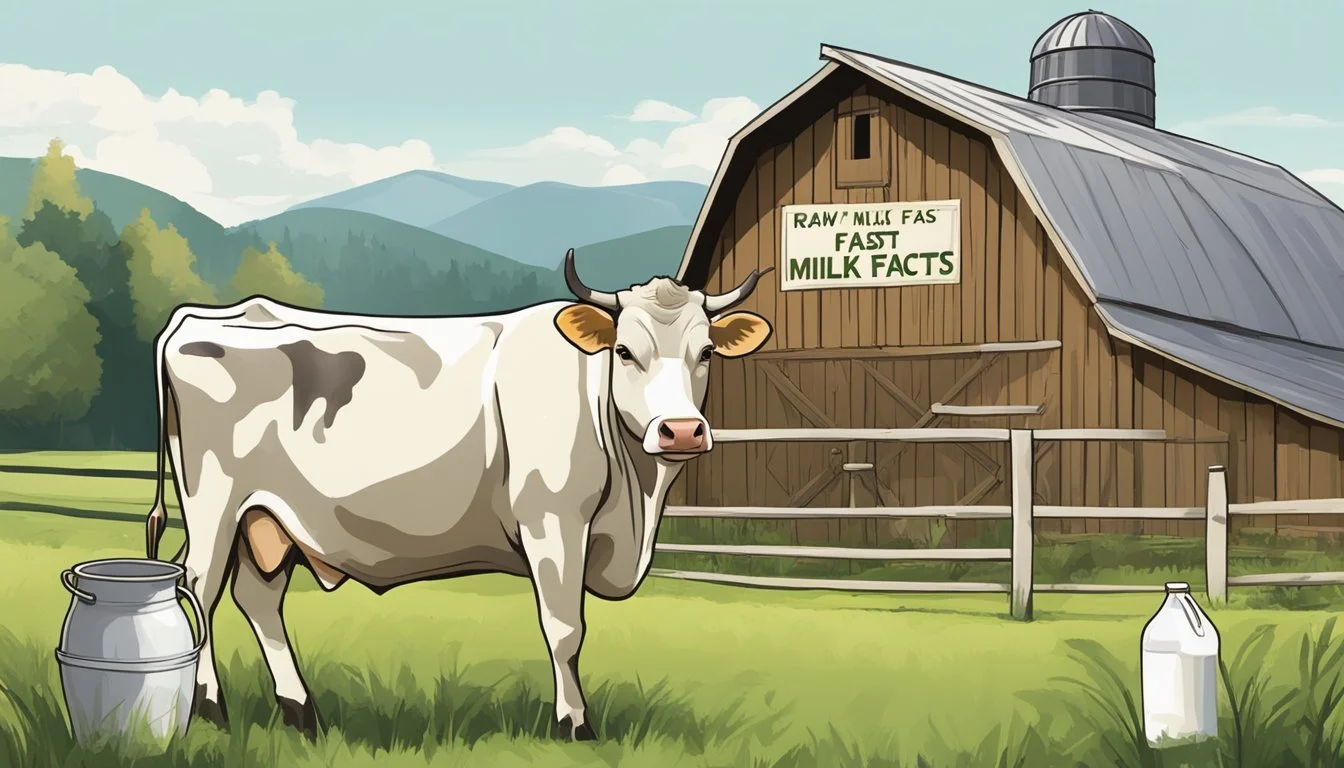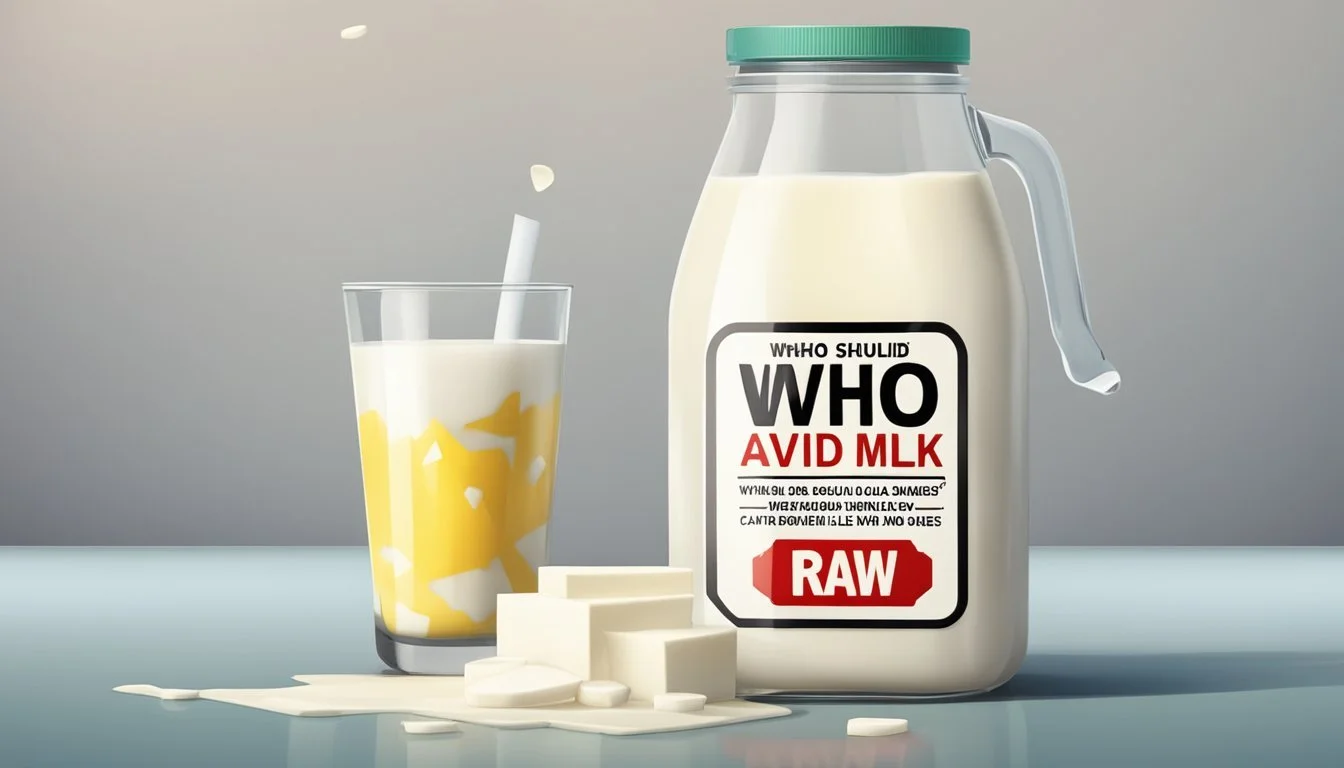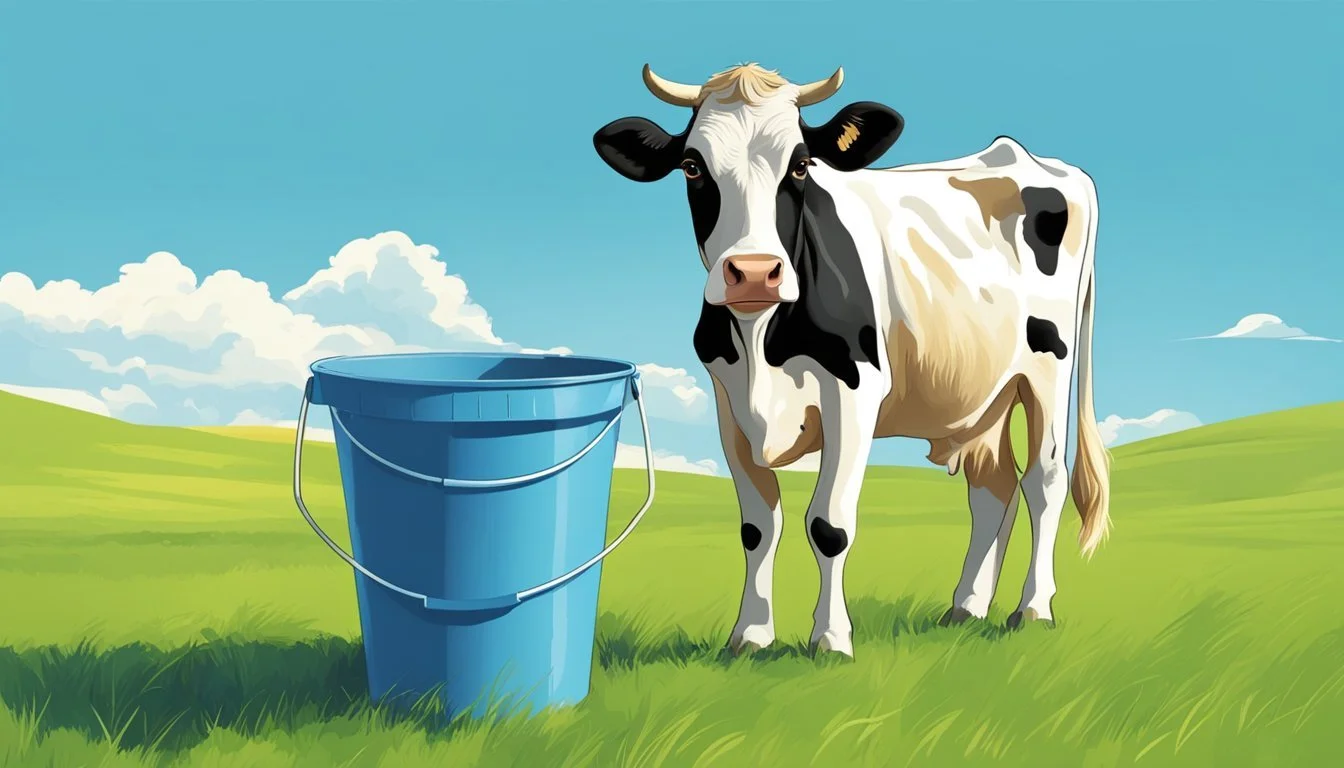Raw Milk Fast Facts
Essential Safety and Nutritional Guidelines for Beginners
Raw milk, directly sourced from cows, sheep, or goats, has gained interest among consumers who prioritize minimally processed foods. While it's the same substance that has nourished populations for millennia before the invention of pasteurization, today's raw milk comes with a set of considerations to ensure safety and quality. In its natural state, without undergoing pasteurization, raw milk retains its original flavor profile and natural enzymes, which some people believe contributes to its nutritional value.
However, raw milk may contain harmful bacteria such as Listeria, Salmonella, and E. coli, which pose significant health risks, especially to certain groups like pregnant women, infants, the elderly, and those with weakened immune systems. The Centers for Disease Control and Prevention (CDC) advises against the consumption of raw milk by these vulnerable groups due to the risk of serious illnesses. Therefore, consumers opting for raw milk should be aware of the potential risks and take steps to mitigate them, such as ensuring the milk is sourced from reputable suppliers who follow strict hygienic practices.
Maintaining the quality and safety of raw milk is crucial once it's in the consumer's hands. Keeping it at a consistently cold temperature is one way to slow down microbial growth and preserve the milk's freshness. It is also essential for consumers to understand that raw milk can naturally sour over time, unlike pasteurized milk, which has a more predictable shelf life due to the bacteria eliminated through pasteurization. Consumers choosing raw milk should be prepared to consume it within a shorter time frame and monitor its freshness closely.
Raw milk is a natural and wholesome source of nutrition that has been enjoyed by many for centuries. The raw milk community values the health benefits and delicious taste of this unprocessed dairy product. Unlike homogenized raw milk, which has undergone a process that breaks down fat globules, raw milk retains its natural composition, making it a popular choice for those seeking a more natural and unaltered dairy option.
One of the most well-known raw milk fast facts is its high calcium raw milk content, which is essential for maintaining strong bones and teeth. Many people believe that consuming raw milk can contribute to better bone health and overall well-being.
In addition to its nutritional value, raw milk is also gaining attention for its potential benefits in skincare. Some individuals use raw milk as a natural ingredient in skincare routines, believing that it can help nourish and hydrate the skin.
The raw vs. pasteurized milk debate continues to spark discussions among dairy enthusiasts, with many advocating for the consumption of raw milk for its potential health advantages. While it's important to consider safety precautions when consuming raw milk, many in the raw milk community believe that when sourced from reputable producers, raw milk can be a valuable addition to a healthy lifestyle.
Understanding Raw Milk
Raw milk is milk from cows, goats, sheep, or other animals that has not undergone pasteurization, a process of heating to destroy potentially harmful bacteria. Proponents of raw milk consumption argue that it contains more vitamins, minerals, and enzymes than its pasteurized counterpart. These natural components may contribute to better digestion and a richer nutrient profile.
Health Risks and Safety Concerns:
Vulnerable Groups: Infants, children, the elderly, and those with compromised immune systems face a higher risk of falling ill from consuming raw milk.
Bacterial Contamination: Pathogens such as Salmonella, E. coli, and Listeria can be present in raw milk, potentially leading to serious illness.
Regulations and Availability:
Raw milk sales are subject to state laws and regulations, and it may not be available in all areas.
Consumers should always source raw milk from reputable farms that follow proper sanitary practices.
Differences from Pasteurized Milk:
Pasteurized milk has been heated to a temperature that kills harmful bacteria without significantly changing the nutritional content.
Dairy products made with pasteurized milk are widely considered safer for public consumption compared to those made with raw milk.
Considerations Before Consumption:
Research dairy sources thoroughly.
Be aware of the signs of milk spoilage, such as sour smell or taste.
Consult with a healthcare provider, especially for those in at-risk groups.
In conclusion, raw milk requires careful handling and an understanding of the risks. Consumers who choose to drink raw milk should be diligent about sourcing from trusted, clean, and tested farms.
Health and Nutritional Benefits
Raw milk offers a range of health and nutritional benefits due to its content of various essential nutrients. It's a natural source of proteins, vitamins, and minerals, all contributing to its potential positive impact on health.
Essential Nutrients in Raw Milk
Raw milk is a rich source of several nutrient elements that are crucial for maintaining good health. Here are some key components found in raw milk:
Proteins: About 8 grams per cup, vital for muscle repair and growth.
Vitamins: Including Vitamin A (6% RDA) and Vitamin B12, important for vision and nervous system health.
Carbohydrates: Present in the form of lactose, providing energy.
Fat: Raw milk contains about 8 grams of fat per cup, with some being healthy omega-3 fatty acids and conjugated linoleic acid, which have anti-inflammatory properties.
Calcium: Approximately 30% of the recommended daily allowance (RDA) in one cup, essential for bone health.
Iron, Phosphorous, Magnesium: Trace minerals necessary for various bodily functions.
Comparing Pasteurized and Raw Milk Benefits
When juxtaposing the benefits of pasteurized and raw milk, there are distinctive differences that consumers should be aware of:
Probiotics: Raw milk often contains probiotics which are beneficial for the digestive system, while pasteurization can destroy these bacteria.
Digestive Enzymes: The natural enzymes in raw milk can aid in digestion; pasteurization may reduce the levels of these enzymes.
Vitamin Content: Some vitamins can be lessened in pasteurized milk due to the heat treatment process, whereas they are retained in raw milk.
Bioavailability: Nutrients in raw milk are in a form that is easily utilized by the body, potentially making it a more effective nutrient source.
It is essential for consumers to be informed about these differences to make choices that align with their health needs and preferences.
Safety Concerns and Risks
When considering raw milk consumption, it's essential to be aware of the safety concerns and risks involved. Unpasteurized milk can harbor dangerous pathogens that pose significant health risks.
Common Bacterial Contaminants
Raw milk can contain harmful bacteria known to cause illness in humans. These contaminants include:
Listeria (Listeria monocytogenes): Can lead to a serious infection, especially in the elderly, newborns, and individuals with weakened immune systems.
E. coli (Escherichia coli): Certain strains can cause severe abdominal cramps, bloody diarrhea, and vomiting.
Campylobacter: Infection can result in diarrhea, cramping, fever, and abdominal pain.
Salmonella: Symptoms can include diarrhea, fever, and abdominal cramps, and in severe cases, the infection can spread from the intestines to the blood, leading to more serious health issues.
These bacteria are particularly concerning for at-risk populations, such as young children, pregnant women, the elderly, and those with compromised immune systems.
Documented Outbreaks and Infections
The Centers for Disease Control and Prevention (CDC) has linked raw milk to several foodborne illness outbreaks. Here are key facts:
From 1993 through 2012, 148 outbreaks due to consumption of raw milk or raw milk products were reported to CDC.
These outbreaks led to 2,384 illnesses, 284 hospitalizations, and 2 deaths.
Outbreaks linked to raw milk are more frequent in states where the sale of it is legal.
Pasteurization and Food Safety
Pasteurization is the process of heating milk to a specific temperature for a set period to kill harmful pathogens that raw milk may harbor. Here's why it's crucial for food safety:
Reduces food safety risk: Pasteurized milk is much less likely to contain the bacteria that cause listeriosis, salmonellosis, and E. coli or Campylobacter infections.
CDC recommendation: The CDC strongly recommends choosing pasteurized milk to prevent foodborne illness, especially among people at higher risk of infection.
Who Should Avoid Raw Milk?
Consuming raw milk carries certain health risks due to the potential presence of harmful bacteria. Therefore, specific groups of individuals are at a higher risk of experiencing severe illness if they choose to consume raw milk. These high-risk groups should avoid raw milk and products made from raw milk:
Infants and Children: Children younger than 5 years of age have delicate immune systems that are not fully developed. As such, they are more susceptible to the pathogens that can be found in raw milk.
Pregnant Women: During pregnancy, a woman's immune system is naturally suppressed. This makes pregnant women and their unborn babies more vulnerable to the bacteria in raw milk, which could lead to infections that may result in miscarriage, fetal death, or illness in newborns.
Immunocompromised Individuals: People with weakened immune systems, including those with conditions such as HIV/AIDS, cancer, diabetes, and certain genetic disorders, should avoid raw milk. The risk of infection and complications from pathogens in raw milk is higher for them.
Elderly Adults: Adults aged 65 years and older often have a diminished immune capacity or underlying health conditions. Consequently, the bacteria in raw milk may pose a serious health threat for this age group.
Individuals with Allergies: Those with dairy allergies should be cautious as raw milk may contain higher levels of milk proteins that can trigger allergic reactions.
It is essential for consumers to recognize these risks and make informed decisions about their milk consumption. Riskier foods, such as raw milk, require careful consideration, particularly for those who fall within the aforementioned groups.
Legal and Regulatory Landscape
The regulatory framework for the sale of raw milk varies significantly across the United States, with states imposing their own specific laws, while federal oversight is primarily managed by the Food and Drug Administration (FDA).
State Regulations on Raw Milk Sale
Each state has the authority to regulate the sale of raw milk. Regulations differ greatly:
California: Raw milk sales are legal both on farms and in retail stores, but only from state-authorized producers.
Massachusetts: Local governments are empowered to set their own raw milk laws, which must be in compliance with specific sections of the state's regulations.
Louisiana: The sale of raw milk for human consumption is prohibited.
Importantly, states that permit raw milk sales may impose restrictions, such as capping the sales volume or mandating warning labels.
Federal Oversight by the FDA
At the federal level, the FDA has jurisdiction, particularly in interstate commerce. The FDA prohibits the interstate sale or distribution of raw milk. They work under the premise that pasteurization is necessary to ensure the safety of milk for public consumption. The FDA oversees producers to ensure compliance with the Pasteurized Milk Ordinance, which sets national standards for milk safety.
Prevalence and Consumption Trends
Recent data reveals a persistent, though limited, demand for raw milk, with distinct trends in consumption across various demographics.
Market Demand for Raw Milk
The market for raw milk, although a niche, indicates a steady demand among consumers. Surveys show that around 1.6% of adults report consuming raw milk at least once a month. This consumer base is likely driven by beliefs in raw milk's health benefits and a preference for natural, unprocessed foods. Despite the potential risks associated with raw milk, its proponents continue to advocate for the choice to purchase and consume these products.
Local Farms and Accessibility
Local farms are at the heart of raw milk's accessibility and play a central role in its supply chain. In the United States, the accessibility of raw milk varies by state, as regulations differ widely. Some states allow raw milk to be sold in retail stores, while others only permit sales directly on farms. This variability is often represented on a map indicating states with more lenient raw milk laws, implying a correlation between these laws and increased sales.
States with Retail Sales States with Farm-only Sales 3.6 times more outbreaks Fewer reported outbreaks
Local farms, therefore, are fundamental to the raw milk market, with state laws serving as a determinant of their prevalence and the associated risk factors for consumers.
Raw Milk Handling and Storage Best Practices
When consumers choose raw milk, they must prioritize food safety and proper storage to ensure its quality and reduce health risks. Since raw milk is not pasteurized, it contains natural enzymes and can host bacteria, making correct handling paramount.
Quick Cooling: After milking, the milk should be chilled rapidly to inhibit bacterial growth. Aim for temperatures below 40°F (4°C).
Glass Containers: Store raw milk in glass containers to maintain freshness and avoid contamination. Glass is non-porous and doesn't transfer flavors.
Storage Tips:
Place milk in the back of the fridge, away from the door to keep a consistent, cold temperature.
Sealed containers are essential to limit exposure to air and other contaminants.
Testing:
Regular testing for pathogens is advised for producers to ensure safety for consumers. While at home, consumers should also be vigilant and discard milk that smells or tastes sour.
One should consume the milk within the recommended timeframe provided by the local health authorities or the producer.
It is crucial for consumers to understand that raw milk's taste and texture may change over time due to natural fermentation processes. If there is any uncertainty about the milk's condition, it is safer to err on the side of caution and avoid consumption.
Potential Allergies and Intolerances
Consuming raw milk could impact those with milk allergies or lactose intolerances. Allergies are immune responses triggered by consuming milk, potentially causing symptoms such as rashes, swelling, or more severe reactions like anaphylaxis. Raw milk contains milk proteins, which can be allergenic. The American Academy of Pediatrics advises against raw milk consumption by children due to the risk of serious illness.
Regarding asthma, studies suggest a potential link between raw milk consumption and a lower incidence of asthma and allergies, but this benefit must be weighed against safety concerns. Raw milk can harbor harmful bacteria that might exacerbate health risks for individuals with asthma.
Lactose intolerance occurs when an individual lacks the enzyme lactase, required to digest lactose in milk. While some claim that raw milk is easier to digest, there is limited scientific evidence to support this claim fully. Lactose intolerant individuals may still experience symptoms when consuming raw milk, such as bloating, gas, and abdominal pain.
Potential Benefit Consideration Lower rates of allergies & asthma* Lack of pasteurization can lead to harmful bacteria. Not recommended for vulnerable groups: children and the elderly.
*Note: The information on benefits is based on studies and is not conclusive. Consumers should weigh potential benefits against the risks and consult healthcare providers.
It is crucial for consumers to make informed decisions and consult with a healthcare professional before introducing raw milk into their diet, especially if they have existing allergies, asthma, or lactose intolerance.
Environmental and Ethical Considerations
When considering the environmental impact of raw milk from cows, sheep, and goats, it's important to note that unprocessed milk production often involves less energy and resources than pasteurized milk due to the absence of the pasteurization process. However, the scale of the farm and its practices play a crucial role in determining its overall environmental footprint.
Organic and small-scale farms that allow animals to graze naturally often have a lower environmental impact. Grazing can help manage land sustainably and promote biodiversity. In contrast, intensive farming systems can lead to higher emissions, land degradation, and a negative impact on animal welfare.
Ethical Practices
Animal Welfare: Ethically minded consumers often prefer raw milk from farms where animals are treated humanely. This includes adequate space, outdoor access, and a natural diet.
Local Supply Chains: By purchasing raw milk locally, consumers can support small farms and reduce the environmental costs associated with transportation.
Production Method Impact
Natural Grazing: Encourages sustainable land management.
Resource Use: Often lower in small-scale, less processed milk production.
Consumers also need to consider the risk of contamination and the importance of high hygiene standards in raw milk production. Raw milk can carry pathogens that are removed during pasteurization, so ethical considerations include the safety measures taken by the producers to ensure consumer health.
In summary, raw milk poses both environmental and ethical considerations that require careful evaluation by new consumers. They must weigh the benefits of supporting local, less-processed milk against the potential risks and ethical implications of the chosen milk source.
Making Informed Choices
When consumers approach the topic of raw milk, they should be equipped with science-based information to make informed decisions. Here are key points new consumers should consider:
Understanding Potential Risks:
Health Vulnerabilities: Certain individuals, including children under 5, seniors over 65, and those with weakened immune systems, are at increased risk of severe illness from raw milk consumption.
Bacterial Exposure: Raw milk can contain harmful bacteria like Listeria, which may lead to serious health complications.
Evaluating Health Benefits:
The perceived nutritional advantages of raw milk have not been supported by conclusive scientific evidence. Consumers must weigh any potential benefits against the clear health risks.
Consideration Description Science-Based Data Research and understand the potential health implications of raw milk. Potential Risks Be aware of the risks associated with bacterial contamination. Health Benefits Scrutinize claims of benefits, considering the lack of scientific proof.
Consumers should engage with credible sources like the CDC and FDA to gather accurate and up-to-date information. These organizations offer resources that help one navigate through the complexities surrounding raw milk. It's essential that consumers analyze these facets with a neutral perspective, focusing solely on the factual data presented. Balance potentially beneficial nutrients with the understood risks to determine if raw milk is right for one's diet.









